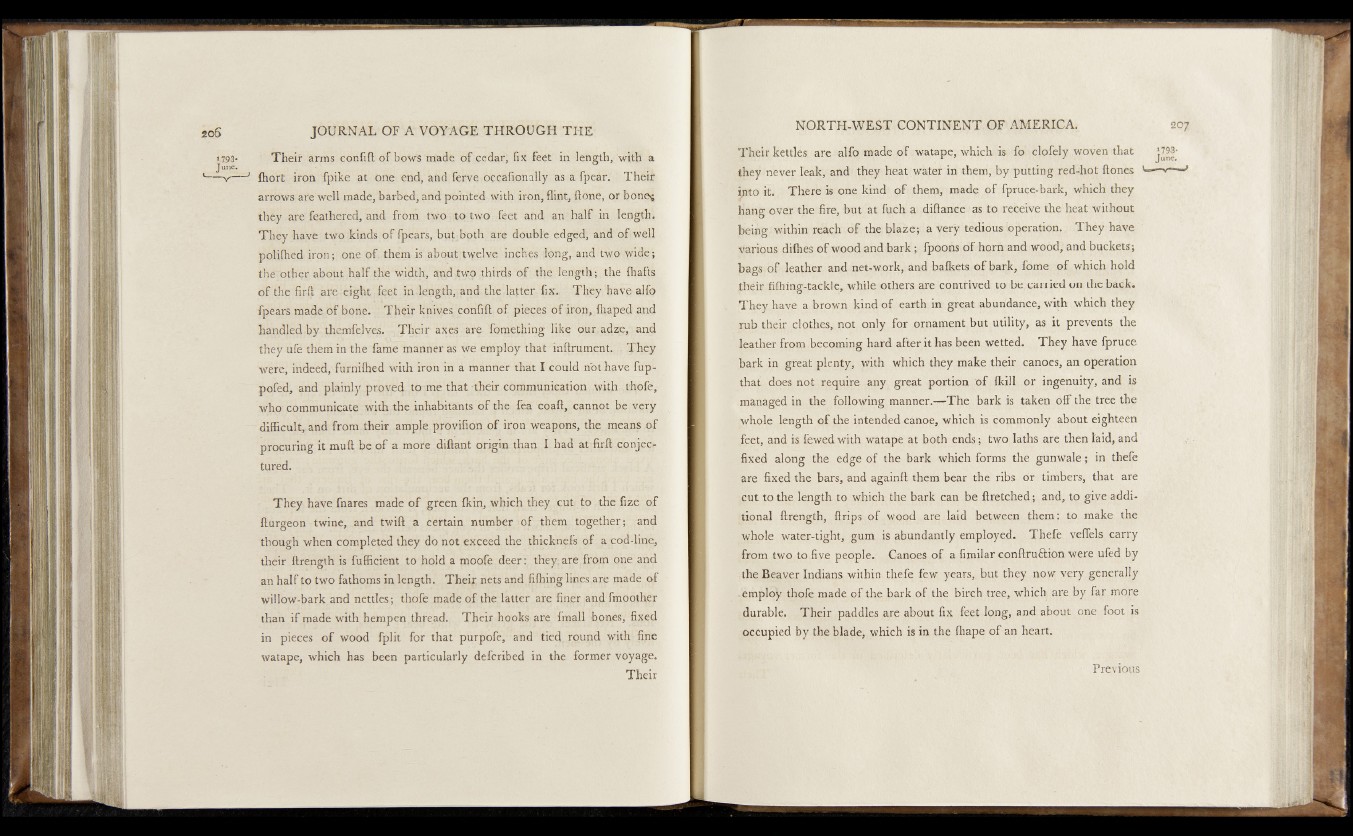
' Their Arms confift of bows made bf ^cedar; fik feCt in. length, with a
fhort Jt&tx Tpike af bii&iCpd;andTeryeopcAfpfoally as a fp'e^r/ Their
arrowSfare well made, barbed;;ahd pointed with iron, flint, fttfne, or bonaj
they/are feathered, and from tWo-jitchtwo, rfeet and an'half in length,
They hayp .two jkindsJof fpears,'but both;/]ar# double edgpd, and o f well
polilhed iron;. One of, themji'.about;twelve iabhesj-flpng, and-twotyicje;
fhe||j^pr about half the width, and twp,thirds of thqdteflStfi j, the fbafts
of-this firljt are;eight feet in .length,. and. Jibe -fa,tt&r Gxv They have alfp
fpears made.df bone. | Thejr kniyes^confift of. pipces of iron,.fhjaped and
handledby themfejyes.Their axpyare fbmething [ike our,^2?^ ,anri
IM^Iafe them io the feme manner as we employ that'dhflrpment. . £he7
ihdeed/fdfhifhed with iron in a manner1 that I'.eould nothave fup-
pofql, and plainfjt.prqyjed torme that tjteir communication r!\yith ,th|ofe^
who: communicate wph;the inhabitants of the fea coaf^cjmnot .hejVqry
difficult^and;froin-iheir, amp|eTprPv^ on of. iron we,appns, the meanspf
procuring it muft be of a more diftant origin than I had atbrffjC.pnjecr
tured.
They have'fnares inade o f green (kin, wlpich they^ppp to
fiiirgeon twine,_and twift a certain number -of^hem,,together;., and
though when completed they do not exceed the thiclenels p f, arco^d-Jine,
their .ftrepgth,is fufficient to hold a moofe deer: they;aye,frqm oxie,apd
an half to two fathoms in, length. Their, nets and ^Ihipg^^p^f QWde t>f
willow-bark, and nettles ; thofe made of the. latter are, fippr and.fmopther
than if made with hempen .thread-, Their hooks are fma.ll bones, fi&qd
in pieces of wood fplit for that purpofe/aod tiedT roupd with - fine
watape, which has been particularly deferibed in the former voyage.
Their
^ffeeir kettles, are alfo made of .watape, which is 'fo' -clp|ely woven that j TSfr
they never leak, and- they heat water in them, bypuitting red-hot (tones *— v—
mto it. There is one kind pf them, made of fpruce-baik, which they
hang over the fire, but at fuch a diftance/as to receive the heat without
being within reach of the blaze;, a very, tediousioperation. They have
Various difhes of wood and bark’; fpqons.ofhoxn and wood, and buckets;
bags,of. leather and net-work, and bafkets of bark, fome of which hpld
their fifcingMfeaekle, while,others are contrived to be, carried onthe back.
Theyjiaye a, brown kind of earth in- great abundance, w ith, which they
rub th£k, clothes,mxt only for ornament,but.utility, as it prevents the
leather from3he©oming hard after it has been wetted. They have fpruce
bark in great plenty., with which they make,them canoes, an operation
that does not require .any great pprtipn qfjfkill or ingenuity, and is
managed in the following manner.— The bark is taken off the, tree the
■ $vhole .length qf pjie intended canoe, which is(commonl,y about eighteen
feet, and i^.fewed.whh watape at both sends-;,,two;laths are then laid, and
infixed along the edge of the bark which forms the gunwale; in tbefe
- are fixpd the bars, and againft them bear the ribs or timbers, that are
.cut to the length ,to which the bark can be ftretched ; and, to giye additional
ftrength, (trips, of .wpqd^aye laid between them:, to make the
■ whole water-tight, gum is abundantly employed. ; T^hefe;ive|TelsT carry
jfrom two, to five people. Canoes of a fimilar conflruftion were ufed.by
the Beaver Indians, within thefe few years, but they .npy* very generally
.'employ thofe madevpf the bajrk^pf.the birph trep, which. ,are by far more
durable, Their paddles afe abput fix .fept Jang, and about one foot.-is
occupied by the blade, which is in, the fhape of an heart.
Previous